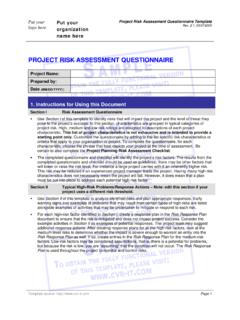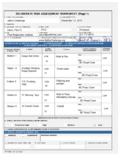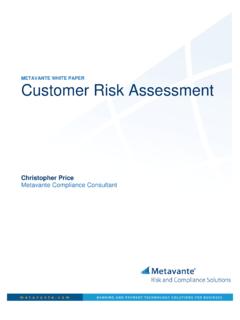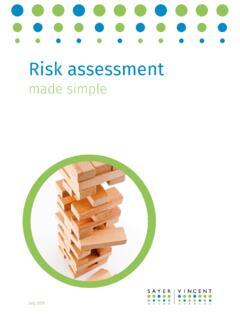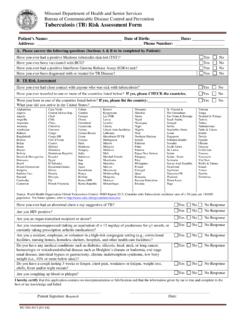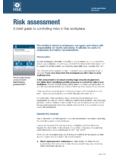Transcription of Financial Action Task Force Groupe d'action financière
1 Financial Action Task Force Groupe d' Action financi re MONEY LAUNDERING & TERRORIST. FINANCING RISK assessment STRATEGIES. 18 June 2008. FATF/OECD 2008. All rights reserved. No reproduction, copy, transmission or translation of this publication may be made without written permission. Applications for permission to reproduce all or part of this publication should be made to: FATF Secretariat, OECD, 2 rue Andr Pascal 75775 Paris Cedex 16, France TABLE OF CONTENTS. Introduction .. 2 I. What is a Risk assessment ? .. 5 Conducting a National ML/TF Risk assessment .. 5 The FATF Recommendations and the Risk assessment Process .. 6 II. Examples of National ML and/or TF Assessments .. 9 Australia .. 9 Belgium .. 10 Canada .. 11 Japan .. 11 Macao, China .. 11 12 Poland .. 12 Spain .. 13 United Kingdom .. 14 United States .. 15 Europol .. 15 Interpol .. 16 III. Issues to Consider When Conducting a national ML/TF Risk assessment .
2 17 Meeting the Needs of the Customer .. 17 Resources and the assessment Process .. 17 Interagency Cooperation .. 18 Data Availability and Quality .. 18 Developing an Ongoing assessment Process .. 18 IV. Sources of Data for a National ML/TF Risk assessment .. 20 Determining the Threat .. 20 Measuring Crime .. 21 Victimisation Surveys .. 22 Offender 23 Other Relevant Data Sources for a Threat 23 Country and Sector ML/TF Vulnerability .. 24 V. Issues for Further Consideration .. 27 Conclusion .. 28 Bibliography .. 29 Appendix 1: Summary of Money Laundering assessment Survey Responses .. 31 Appendix 2: Evaluating Law Enforcement Effectiveness .. 36 Appendix 3: Estimating the Total Scope of Money Laundering .. 39 ACRONYMS. AML Anti-money laundering CDD Customer due diligence CFT Combating the financing of terrorism DNFBPs Designated non- Financial businesses and professions FATF Financial Action Task Force FI Financial institution FIU Financial intelligence unit FSRB FATF-style regional body IMF International Monetary Fund LEA Law enforcement agency ML Money laundering RBA Risk-based approach SAR Suspicious activity report SSI Strategic surveillance initiative STR Suspicious transaction report TF Terrorist financing WGTYP Working Group on Typologies WB World Bank INTRODUCTION.
3 1. Understanding the sources and methods of money laundering and terrorist financing in a jurisdiction is essential for competent authorities to develop and implement an effective anti-money laundering/counter-terrorist financing (AML/CFT) programme. A national money laundering/terrorist financing (ML/TF) risk assessment should be considered the foundation for setting AML/CFT policy priorities and resource allocation. 2. The purpose of this report is to provide information on developing a national ML/TF risk assessment . There are obvious similarities and differences between money laundering and terrorist financing, but the risks of both are often assessed and managed using the same information flows between public and private sector institutions. 1. 3. The Financial Action Task Force (FATF) typology report, Terrorist Financing, published in February 2008 notes: The application of the FATF 40 Recommendations and 9 Special Recommendations provides a solid basis upon which to gather Financial information.
4 Leveraging this Financial information with wider information on counterterrorism, including intelligence, at a national level may prove to be the most effective use of Financial information in identifying terrorist activity. 2. 4. The terminology used in this paper as well as the risk management principles and procedures that are presented draw heavily on the June 2007 FATF paper, Guidance on the Risk-Based Approach to Combating Money Laundering and Terrorist Financing (RBA paper). 3 The RBA paper defined a risk management process for dealing with money laundering and terrorist financing that encompasses i) recognising the existence of risks ; ii) undertaking an assessment of the risk(s); and iii). developing strategies to manage and mitigate the identified risks . 4 This paper offers methodologies for undertaking the risk assessment portion of that framework at the national level.
5 5. Although depth of coverage may differ, a national ML/TF risk assessment is a process that typically presents information on: The nature and scale of ML/TF and related predicate crimes ( the threat). Weaknesses in AML/CFT systems and controls and other features of a jurisdiction that make it attractive to money launderers and terrorist financiers ( the vulnerability). 5. 6. The purpose of a national ML/TF risk assessment is to identify money laundering and terrorist financing methods across a jurisdiction and to determine how often those methods are used, how 1. Although intelligence sources provide insights into terrorist financing activities, that information and information related to money laundering gathered from law enforcement flows to the private sector as risk management guidance, advisories, and targeted economic sanctions. The private sector also is alerted to risks regarding specific individuals, entities, and transactions through information requests received from law enforcement.
6 Relevant ML/TF information flows the other way as well, through currency and transaction reporting from Financial institutions required to file such reports. 2. FATF (2008). 3. FATF (2007a). 4. Ibid. 5. There are currently no standard definitions used internationally within the AML/CFT context for the terms risk, threat, and vulnerability. This project identifies concepts linked to these terms in order to promote a consistent approach by countries, but does not go so far as to suggest precise definitions for adoption by the international community. Having a clear understanding of what the concepts mean, however, will assist countries when establishing the terms of reference and scale of ambition when conducting a national ML/TF assessment . 2. effective they are in moving illicit funds, and whether there are gaps in the AML/CFT systems and controls. 7. A national ML/TF risk assessment should be regarded as fundamental background information to assist supervisors, law enforcement authorities, the Financial intelligence unit (FIU), and Financial institutions.
7 6 This requires that competent authorities periodically renew their awareness of current money laundering and terrorist financing methods and reassess the effectiveness of established safeguards. 8. The ML/TF risk assessment process should inform a consideration of whether current laws are sufficient to address new threats, and whether current methods of supervision and enforcement are adequate. Where the law is inadequate, there is vulnerability. Where the law is adequate, but supervision and examination are weak law enforcement will be overwhelmed. Where law enforcement is weak, the law has little deterrent effect. 9. Conducting a risk assessment should be useful to policymakers in identifying AML and CFT. priorities. The principle is that resources should be directed in accordance with priorities so that the greatest risks receive the highest attention. 7 Assessments should be tied to strategic planning and linked to specific actions.
8 10. In addition to identifying high priority ML/TF risks at the national or jurisdictional level, aggregating risk assessments across jurisdictions will help to identify priority concerns at the international level. To support the goal of producing a global threat assessment , the February 2008. FATF plenary initiated the Strategic Surveillance Initiative (SSI). The SSI process includes aggregating existing national ML/TF risk assessments, surveying FATF and FATF-style regional body members regarding emerging trends and high priority ML/TF risks , fact-finding by the FATF. Secretariat, and discussion in the FATF Working Group on Typologies (WGTYP). 11. This project was undertaken in the FATF WGTYP. The co-chairs of the project were the International Monetary Fund (IMF), United Kingdom (UK), United States (US) and World Bank. Source material for the project included a review of the relevant literature, consultation with Dr.
9 Peter Reuter 8 and Dr. Matthew Hitchcock Fleming, 9 survey responses from FATF members describing jurisdictional risk assessment methodologies and terminology, contributions from the core project group 10 and related discussions in Bangkok, Thailand at the November 2007 FATF Typologies Experts' Meeting. 12. The first section of the report describes what a national ML/TF risk assessment is and what a risk assessment project entails. While the risks and the priorities may vary from one country to another, much of the information gathering and even the assessment process are built into the FATF. Recommendations. 11 The 40+9 Recommendations and the role of Financial institutions, regulatory and supervisory authorities, Financial intelligence units, and law enforcement are mapped to the assessment process in this first section. 6. Ibid. 7. For more on why to conduct a national money laundering/terrorist financing risk assessment , refer to FATF (2007a).
10 8. Dr. Reuter is a professor in the School of Public Policy and the Department of Criminology at the University of Maryland in the United States. 9. Dr. Fleming is currently serving as a Highly Qualified Expert with the US Department of Defense; he was a consultant on AML/CFT matters with the IMF at the time of drafting of this report. He has also held positions with the IMF, World Bank, United Nations, and with University College London's Jill Dando Institute of Crime Science. 10. In addition to the IMF, UK, US and World Bank, the core project team included Australia, Belgium, and the Netherlands. 11. See The FATF 40+9 Recommendations . 3. 13. The second section of the report presents examples of jurisdictional risk assessments covering money laundering and/or terrorist financing. The methodology and output of these efforts varies, but together they illustrate the many approaches that can be taken to understand how terrorists and criminals move money within a jurisdiction.










